I tried to operate a part of a qt project in Qt\Examples\Qt-5.9\quick\views, I am new to qml and I am trying to open each time a different QDialog window depending on qml pathview component that has been clicked. First of all, I started with creating a class (interfacageQML) which will serve to interface the qml Mainform and the QDialog (qtinterface), the necessary files are included among which interfacageqml.h.
here is the main.cpp :
#include "interfacageqml.h"
int main(int argc, char *argv[])
{
QGuiApplication app(argc, argv);
qmlRegisterType<interfacageQML>("Interfacage", 1, 0,"Component:MouseArea");
QQmlApplicationEngine engine;
engine.load(QUrl(QStringLiteral("qrc:/main.qml")));
return app.exec();
}
And here's interfacageqml.h :
#ifndef INTERFACAGEQML_H
#define INTERFACAGEQML_H
#include <QObject>
#include "qtinterface.h"
class interfacageQML : public QObject
{
Q_OBJECT
public:
interfacageQML(QObject *parent);
~interfacageQML();
Q_INVOKABLE void mouseClick();
signals:
void clicked();
};
#endif // INTERFACAGEQML_H
interfacageqml.cpp :
#include "interfacageqml.h"
#include <QDebug>
#include <QApplication>
interfacageQML::interfacageQML(QObject *parent)
: QObject(parent)
{
}
interfacageQML::~interfacageQML()
{
}
void interfacageQML::mouseClick()
{
qDebug() << "qmlinterface::mouseClick()";
emit clicked();
}
My project is organised this way :
the qmlinterface.qrc file contains these paths:
main.qml :
import QtQuick 2.6
import QtQuick.Window 2.2
Window {
visible: true
width: 640
height: 480
title: qsTr("Hello World")
MainForm{
anchors.fill: parent
}
}
MainForm.qml :
import QtQuick 2.6
import QtQuick.Controls 2.0 as QQC2
import Interfacage 1.0
Rectangle {
width: 800
height: 800
color: "white"
ListModel {
id: appModel
ListElement {
name: "Contacts"
icon: "pics/Resources/AddressBook_48.png"
}
ListElement {
name: "Music"
icon: "pics/Resources/AudioPlayer_48.png"
}
ListElement {
name: "Movies"
icon: "pics/Resources/VideoPlayer_48.png"
}
ListElement {
name: "Camera"
icon: "pics/Resources/Camera_48.png"
}
ListElement {
name: "Calendar"
icon: "pics/Resources/DateBook_48.png"
}
ListElement {
name: "Todo List"
icon: "pics/Resources/TodoList_48.png"
}
}
Component {
id: appDelegate
Item {
width: 100
height: 100
scale: PathView.iconScale
Image {
id: myIcon
y: 20
anchors.horizontalCenter: parent.horizontalCenter
source: icon
}
Text {
anchors {
top: myIcon.bottom
horizontalCenter: parent.horizontalCenter
}
text: name
}
MouseArea {
anchors.fill: parent
onClicked: {
view.currentIndex = index
Interfacage.mouseClick
}
}
}
}
Component {
id: appHighlight
Rectangle {
width: 100
height: 80
color: "lightsteelblue"
}
}
PathView {
id: view
anchors.fill: parent
highlight: appHighlight
preferredHighlightBegin: 0.5
preferredHighlightEnd: 0.5
focus: true
model: appModel
delegate: appDelegate
path: Path {
startX: 50
startY: 80
PathAttribute {
name: "iconScale"
value: 2.0
}
PathQuad {
x: 250
y: 200
controlX: 50
controlY: 200
}
PathAttribute {
name: "iconScale"
value: 2.0
}
PathQuad {
x: 600
y: 50
controlX: 400
controlY: 200
}
PathAttribute {
name: "iconScale"
value: 2.0
}
}
}
}
When I run this project, i got an error :
error:C2280
However, when I comment this line : qmlRegisterType<interfacageQML>("Interfacage", 1, 0, "Component:MouseArea"); the project runs and I can navigate between the pathview components in the MainForm.

